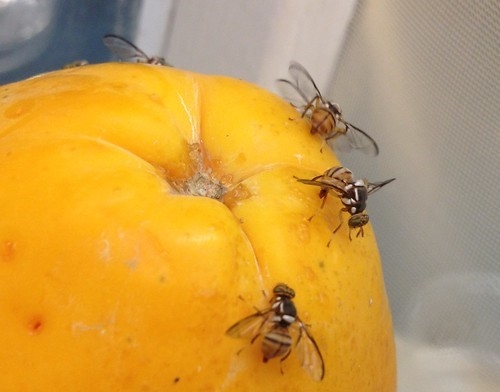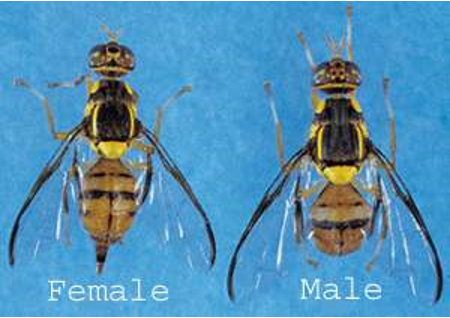(Este post está disponible en español)
In early September 2023, nearly the entire growing area around the city of Brentwood was put under a quarantine by the California Department of Food and Agriculture (CDFA) (see current included area). This severe regulatory measure was triggered by numerous finds of the oriental fruit fly by Contra Costa County's Department of Agriculture during routine monitoring. This exotic pest (meaning that it is not established in the U.S.) is on the United States Department of Agriculture's (USDA) list of non-native species that pose the greatest potential threat to agriculture and the environment. Given the strict and potentially costly treatment and record-keeping requirements in the middle of a busy harvest season, and, for some in the growing community, outright losses, many are likely wondering why this pest is so great a concern.
What is the Oriental fruit fly and why is it a threat to agriculture?

These include most fruit crops grown in the Brentwood area and in California, in general, including most pome and stone fruit (apple, apricot, cherry, peach and nectarine, pear and plum), most citrus fruit, grape and walnut, as well as specialty market fruits such as avocado, fig, persimmon and pomegranate, to name a few.
Vegetable fruits are also susceptible, including bell pepper, cucumbers, melons and squashes and tomatoes. (Curiously, almonds, olives, strawberries and pumpkins* are not considered hosts, and are not under quarantine restrictions.) Tropical fruits, like guava, mango, and papaya, which are not grown in our region but often sold in open markets, are also favorites of the pest. (See this link for CDFA's abbreviated host list.)
OFF is considered to be one of the most destructive pests in its current range, which includes Southeast Asia, where it appears to have originated, and sub-Saharan Africa, where it has spread rapidly after being introduced only two decades ago. In Hawaii, where it was introduced in the 1940s and subsequently became established, it is a major pest of nearly all commercially grown produce. The combination of a high potential to damage fruit and a very wide host range, as well as its great reproductive capacity, make this pest one of the highest priorities for exclusion from California and other parts of the mainland United States. In addition to costs associated with direct losses of damaged fruit and new management treatments, if this pest were to become established, it would severely impact export markets for nearly all major commodities. Due to its destructive potential, the pest is under aggressive management where it occurs and is subject to exclusion measures in many regions including Europe, Africa and Asia.
Like other fruit fly pests, the damage done to fruit by OFF is caused by the larval stage. Female flies insert eggs into the flesh of ripe or, less preferentially, green fruits using a piercing organ similar to a stinger called an ovipositor (see photo below). The worm-like larvae feed on the fruit pulp under the skin until they are ready to pupate, at which point they eat their way out of the fruit and drop into the soil. In addition to the risk that consumers find maggots (the larval stage) in the fruit, the damage they cause in fruit make it more susceptible to secondary decay by fungi and bacteria. OFF can go from egg to adult in a little over two weeks, and can be ready to reproduce again in about 30 days, and a single female may lay more than 1,000 eggs in its lifetime!
Regulatory efforts to exclude high impact pests
OFF is one of several exotic fruit flies regulated by the federal government and that are monitored by county agricultural departments in coordination with the state, as part of their mission to protect the state's agricultural producers and the environment from new pests and diseases. Other exotic flies actively under exclusion efforts are Mediterranean fruit fly (MedFly) and Mexican fruit fly. A similar quarantine and eradication were implemented in Solano County for MedFly a few years ago. Unlawfully imported fruit are considered the main way that these pests find their way into the country.
OFF is regularly detected in California, but, fortunately, many quarantine and eradication efforts in the past have been implemented successfully. Most quarantines have been in urban areas that did not substantially affect agriculture in surrounding areas. Unfortunately, the finds in Brentwood have affected significant acreage in and around the city. This is perhaps another challenge of the urban-agriculture interface in our region which otherwise offers many benefits, like the thriving U-pick business. A quarantine and eradication effort have also been put in place for Santa Clara County since late August. Eradication treatments entail the attraction of male flies to "bait stations" containing an attractant and a biological insecticide, which is approved for use in organic agriculture. The process is described in some detail in the CDFA's OFF fact sheet.
What this quarantine means for Brentwood area growers
Growers in the quarantined area (see the map linked here for current boundaries) cannot sell or ship produce off of their property without a compliance agreement. The Contra Costa County Department of Agriculture held a joint meeting with the CDFA at the Knightsen Farm Center on September 7 to explain the quarantine and compliance requirements.
Compliance requires growers to make a certain number of treatment applications on a specified schedule under the supervision of state or county agents The Department of Agriculture will provide details on compliance requirements and treatment options. During warm, summer conditions, treatments can be completed in as little as 30 days, but as we go into the cooler, autumn months, the required treatment window expands due to slower development of OFF. Therefore, it is critical to begin the compliance process with the agriculture department as soon as possible. For produce destined for processing, such as processing tomatoes, winegrapes and walnuts, the requirements are somewhat more flexible, but it is still essential to contact the agriculture department to set up a compliance agreement as soon as possible before harvest.
There are treatment options for organic growers. The quarantine is expected to extend at least through the beginning of next year's growing season, so it is essential for growers to plan ahead for next year's crop, as well.
More information is available at the resources listed below.
* Note that though pumpkin and related types of Cucurbita pepo appear on the comprehensive host list, CDFA authorities have stated that this species is no longer regulated. Please check with the Contra Costa County Department of Agriculture.
References and Sources:
- Oriental Fruit Flies Detected in Contra Costa County Quarantine Forthcoming Contra Costa County Department of Agriculture News Release August 30, 2023
- Oriental Fruit Fly Regulation and Quarantine Boundaries, California Department of Food and Agriculture
- Oriental Fruit Fly Fact sheet, California Department of Food and Agriculture
- Oriental Fruit Fly Pest Profile, California Department of Food and Agriculture
- Current Exotic Fruit Fly Quarantines in California, California Department of Food and Agriculture
- Featured Creatures University of Florida IFAS
- State Takes Emergency Action to Eradicate Oriental Fruit Flies Found in City of Santa Clara. County of Santa Clara Office of Communications and Public Affairs
Scientific articles:
- Capinera, John L. “Oriental Fruit Fly, Bactrocera Dorsalis (Hendel) (Diptera: Tephritidae).” In Encyclopedia of Entomology, edited by John L. Capinera, 2690–92. Dordrecht: Springer Netherlands, 2008.https://doi.org/10.1007/978-1-4020-6359-6_1882.
- Mutamiswa, Reyard, Casper Nyamukondiwa, Gerald Chikowore, and Frank Chidawanyika. “Overview of Oriental Fruit Fly, Bactrocera Dorsalis (Hendel) (Diptera: Tephritidae) in Africa: From Invasion, Bio-Ecology to Sustainable Management.” Crop Protection 141 (March 2021): 105492.https://doi.org/10.1016/j.cropro.2020.105492.
- Wei, Dong, Wei Dou, Mingxing Jiang, and Jinjun Wang. “Oriental Fruit Fly Bactrocera Dorsalis (Hendel).” In Biological Invasions and Its Management in China, edited by Fanghao Wan, Mingxing Jiang, and Aibin Zhan, 267–83. Dordrecht: Springer Netherlands, 2017.https://doi.org/10.1007/978-94-024-0948-2_15.
